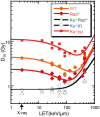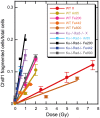Misrepair of DNA double-strand breaks after exposure to heavy-ion beams causes a peak in the LET-RBE relationship with respect to cell killing in DT40 cells
- PMID: 23722078
- PMCID: PMC3823785
- DOI: 10.1093/jrr/rrt064
Misrepair of DNA double-strand breaks after exposure to heavy-ion beams causes a peak in the LET-RBE relationship with respect to cell killing in DT40 cells
Abstract
To determine the radiobiological mechanisms underlying relative biological effectiveness (RBE) and the repair efficiencies of DNA double-strand breaks (DSBs) as a function of linear energy transfer (LET), we exposed cells of the chicken B-lymphocyte cell line DT40 and its DSB repair pathway-deficient derivatives to heavy-ion beams produced at the Heavy-Ion Medical Accelerator in Chiba (HIMAC) at the National Institute of Radiological Sciences (NIRS), Chiba, Japan. The relationship between LET and cell lethality was investigated in the DNA DSB repair gene knockouts Ku70(-/-), Rad54(-/-), and Ku70(-/-)Rad54(-/-), and in the wild-type cells. We found that cell-cycle stage and activity of the DNA DSB repair pathways influence LET-mediated biological effects. An expected LET-RBE relationship was observed in the cells capable of DNA repair, but no peak was found in the RBE with respect to cell survival in the Ku70(-/-)Rad54(-/-) cells or in Ku70(-/-) cells in the G1 and early S cell-cycle phases (when no sister chromatids were present and homologous recombination could not occur). These findings suggest that the peak in RBE is caused by deficient repair of the DNA DSBs.
Keywords: heavy ion; linear energy transfer; misrepair; relative biological effectiveness; sensitivity.
Figures




Similar articles
-
Relative biological effectiveness of high linear energy transfer α-particles for the induction of DNA-double-strand breaks, chromosome aberrations and reproductive cell death in SW-1573 lung tumour cells.Oncol Rep. 2012 Mar;27(3):769-74. doi: 10.3892/or.2011.1604. Epub 2011 Dec 21. Oncol Rep. 2012. PMID: 22200791
-
Effects of indirect actions and oxygen on relative biological effectiveness: estimate of DSB induction and conversion induced by gamma rays and helium ions.J Radiat Res. 2015 Jul;56(4):691-9. doi: 10.1093/jrr/rrv025. Epub 2015 Apr 22. J Radiat Res. 2015. PMID: 25902742 Free PMC article.
-
Comparison of RBE values of high-LET α-particles for the induction of DNA-DSBs, chromosome aberrations and cell reproductive death.Radiat Oncol. 2011 Jun 8;6:64. doi: 10.1186/1748-717X-6-64. Radiat Oncol. 2011. PMID: 21651780 Free PMC article.
-
Repair of DNA damage induced by accelerated heavy ions--a mini review.Int J Cancer. 2012 Mar 1;130(5):991-1000. doi: 10.1002/ijc.26445. Epub 2011 Oct 23. Int J Cancer. 2012. PMID: 21935920 Review.
-
A comparison of mechanism-inspired models for particle relative biological effectiveness (RBE).Med Phys. 2018 Nov;45(11):e925-e952. doi: 10.1002/mp.13207. Med Phys. 2018. PMID: 30421808 Review.
Cited by
-
Heavy-Ion Carbon Radiation Regulates Long Non-Coding RNAs in Cervical Cancer HeLa Cells.J Cancer. 2019 Aug 28;10(21):5022-5030. doi: 10.7150/jca.30846. eCollection 2019. J Cancer. 2019. PMID: 31602253 Free PMC article.
-
Overcoming radioresistance in WiDr cells with heavy ion irradiation and radiosensitization by 2-deoxyglucose with photon irradiation.Clin Transl Radiat Oncol. 2019 Aug 20;19:52-58. doi: 10.1016/j.ctro.2019.08.003. eCollection 2019 Nov. Clin Transl Radiat Oncol. 2019. PMID: 31517070 Free PMC article.
-
Proteomic Analysis Implicates Dominant Alterations of RNA Metabolism and the Proteasome Pathway in the Cellular Response to Carbon-Ion Irradiation.PLoS One. 2016 Oct 6;11(10):e0163896. doi: 10.1371/journal.pone.0163896. eCollection 2016. PLoS One. 2016. PMID: 27711237 Free PMC article.
-
A Critical Review of Radiation Therapy: From Particle Beam Therapy (Proton, Carbon, and BNCT) to Beyond.J Pers Med. 2021 Aug 23;11(8):825. doi: 10.3390/jpm11080825. J Pers Med. 2021. PMID: 34442469 Free PMC article. Review.
-
Equivalency of the quality of sublethal lesions after photons and high-linear energy transfer ion beams.J Radiat Res. 2017 Nov 1;58(6):803-808. doi: 10.1093/jrr/rrx030. J Radiat Res. 2017. PMID: 28992250 Free PMC article.
References
-
- Shrivastav M, DeHaro LP, Nickoloff JA. Regulation of DNA double-strand break repair pathway choice. Cell Res. 2008;18:134–47. - PubMed
-
- Collis SJ, DeWeese TL, Jeggo PA, et al. The life and death of DNA-PK. Oncogene. 2005;24:949–61. - PubMed
-
- Featherstone C, Jackson SP. Ku, a DNA repair protein with multiple cellular functions? Mutat Res. 1999;434:3–15. - PubMed
MeSH terms
LinkOut - more resources
Full Text Sources
Other Literature Sources

